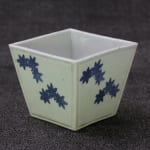




artisan's name unknown
Koimari momijimon kakuchoko set of 5, ca mid-17th century
old Imari ware
2 ¾” x 3” x 3”
Further images
It is an unexpectedly satisfying to palm the angled edges of this cup, Koimari momijimon, in your hand. Instead of replicating the hand’s organic curves and contours, this small cup...
It is an unexpectedly satisfying to palm the angled edges of this cup, Koimari momijimon, in your hand. Instead of replicating the hand’s organic curves and contours, this small cup refutes them. Although its original box says that the cup is a choko ( name for a sake cup in our modern world ), during the Edo period (1603-1892) when the term coined was to refer to a serving container that was used for both food and sake. Once the food in the cup had been eaten, a small amount of sake was poured into the dish. It was then swished around and drunk to so that the lingering flavors of the food and the sake could coalesce.
Its robust but sharp edges announce its novelty of an experience that lies somewhere between eating and drinking: a sort of end-of-course custom, so to speak. Its design functions as a subtle nudge to sharpen textural awareness during the already heightened sensory experience of a meal.
While it rings with the feeling of the new, this cup is an example of ko-imari (old Imari) ware. Unlike the multicolored, sometimes gaudy ornamental patterns of later Imari for the export, ko-imari is distinguished by refinement; these early examples are the most desirable. They were in the group of the first of their kind in this style, rich with the simplicity and ingenuity before it was bogged down by convention. This cup feels new because it is among the oldest, the first, and it contains that curious energy of discovery.
Its robust but sharp edges announce its novelty of an experience that lies somewhere between eating and drinking: a sort of end-of-course custom, so to speak. Its design functions as a subtle nudge to sharpen textural awareness during the already heightened sensory experience of a meal.
While it rings with the feeling of the new, this cup is an example of ko-imari (old Imari) ware. Unlike the multicolored, sometimes gaudy ornamental patterns of later Imari for the export, ko-imari is distinguished by refinement; these early examples are the most desirable. They were in the group of the first of their kind in this style, rich with the simplicity and ingenuity before it was bogged down by convention. This cup feels new because it is among the oldest, the first, and it contains that curious energy of discovery.
Signup for our Newsletter
You will receive two emails a month from us. One introduces artworks and design works from Kyoto's hidden sources and the other is stories from Misako, sharing insights into Japanese culture.
* denotes required fields
为了回应您的查询,我们将根据我们的隐私政策处理您提供的个人数据。




